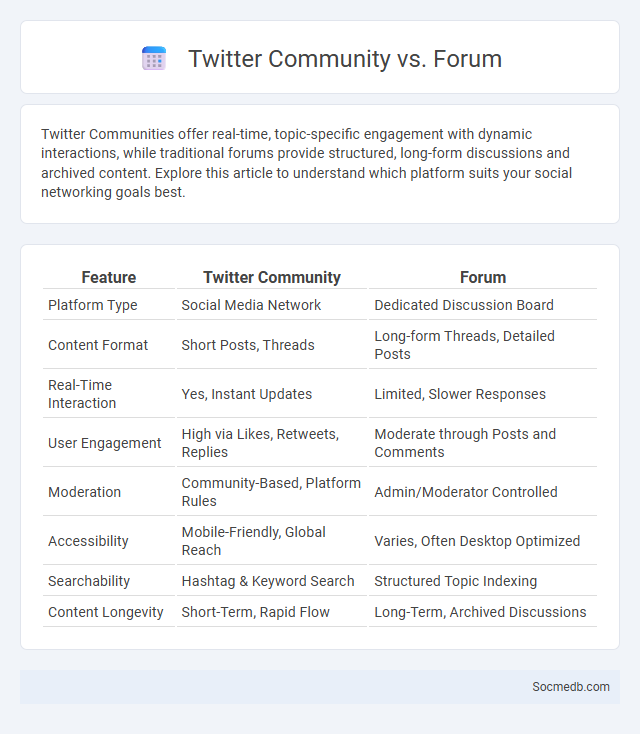
Photo illustration: Twitter Community vs Forum
Twitter Communities offer real-time, topic-specific engagement with dynamic interactions, while traditional forums provide structured, long-form discussions and archived content. Explore this article to understand which platform suits your social networking goals best.
Table of Comparison
| Feature | Twitter Community | Forum |
|---|---|---|
| Platform Type | Social Media Network | Dedicated Discussion Board |
| Content Format | Short Posts, Threads | Long-form Threads, Detailed Posts |
| Real-Time Interaction | Yes, Instant Updates | Limited, Slower Responses |
| User Engagement | High via Likes, Retweets, Replies | Moderate through Posts and Comments |
| Moderation | Community-Based, Platform Rules | Admin/Moderator Controlled |
| Accessibility | Mobile-Friendly, Global Reach | Varies, Often Desktop Optimized |
| Searchability | Hashtag & Keyword Search | Structured Topic Indexing |
| Content Longevity | Short-Term, Rapid Flow | Long-Term, Archived Discussions |
Twitter Community: An Overview
Twitter Community fosters engagement by connecting users with shared interests, promoting real-time conversations and collaboration. Your interactions within these communities enhance content visibility through targeted hashtags, retweets, and replies. Leveraging Twitter Community optimizes networking opportunities and amplifies your social media presence effectively.
Online Forums: Classic Digital Gathering Spaces
Online forums remain vital digital gathering spaces where communities engage in in-depth discussions, knowledge sharing, and peer support across diverse interests such as technology, gaming, and health. Platforms like Reddit and Stack Exchange exemplify the enduring relevance of these forums by fostering specialized subcommunities with rich, searchable content. Their structured threads and archived conversations contribute to long-term information accessibility and digital culture preservation.
What Defines an Online Community?
An online community is defined by a group of individuals who share common interests, goals, or values and interact through digital platforms such as social media networks, forums, or specialized websites. Key characteristics include user-generated content, meaningful engagement, and a sense of belonging fostered by regular communication and shared experiences. Your participation and contributions help shape the community's identity and strengthen connections among its members.
Platform Structures: How Each Fosters Engagement
Social media platforms utilize unique structures to enhance user engagement by tailoring content delivery algorithms that prioritize relevance and timeliness, such as Instagram's visual grid promoting discovery through hashtags and TikTok's For You page leveraging artificial intelligence to customize video feeds. Features like Facebook's Groups and LinkedIn's professional networking tools encourage community building and meaningful interactions, fostering stronger connections among users. Understanding these platform-specific dynamics helps you optimize content strategies to effectively engage and grow your audience.
Content Moderation and Community Guidelines
Content moderation is essential for maintaining safe and respectful social media platforms by filtering harmful, inappropriate, or illegal content through automated tools and human reviewers. Community guidelines establish clear rules that define acceptable behavior, protect users from harassment, misinformation, and hate speech, and foster positive interactions. Platforms like Facebook, Twitter, and Instagram regularly update these policies to address evolving challenges such as deepfakes, extremism, and cyberbullying.
Member Interaction and Communication Styles
Effective member interaction on social media platforms involves personalized communication styles that foster engagement and build community trust. Your content should encourage meaningful dialogue through responsive comments, direct messages, and interactive features like polls and live sessions. Tailoring communication to suit diverse audience preferences enhances connection and promotes active participation.
Discoverability and Growth Potential
Optimizing your social media profiles with relevant keywords and hashtags significantly boosts discoverability by aligning content with user search behavior. Consistent posting schedules and engagement with followers increase your growth potential by fostering community trust and expanding reach through algorithm favorability. Leveraging analytics tools enables you to refine strategies, targeting audiences more effectively for accelerated social media growth.
Privacy and User Control
Social media platforms implement advanced privacy settings that allow users to customize who can view their content and access personal information, enhancing user control over data exposure. Encryption technologies and consent-based data sharing further protect user interactions, mitigating risks associated with unauthorized data usage. Transparent privacy policies combined with regular updates empower users to stay informed about data practices and manage permissions effectively.
Use Cases: Which Platform Fits Your Needs?
Choosing the right social media platform depends on your target audience and content type, with Instagram excelling in visual storytelling for brands focusing on lifestyle and fashion, while LinkedIn suits B2B companies seeking professional networking and thought leadership. TikTok drives engagement through short-form video content ideal for reaching younger demographics, and Facebook remains effective for community building and diverse ad targeting options. Twitter offers real-time conversation and news dissemination, making it optimal for industries requiring instant updates and customer interaction.
Choosing the Right Platform for Your Community Goals
Identifying the social media platform that aligns with your community goals requires analyzing user demographics, content formats, and engagement features of each option. Platforms like Facebook and LinkedIn excel in fostering professional networks, while Instagram and TikTok drive visual and short-form content interaction. Tailoring your strategy to the platform's strengths enhances community growth, member interaction, and goal achievement.
 socmedb.com
socmedb.com